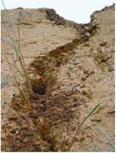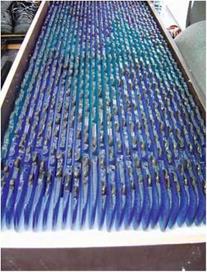|
Glass droplets – water droplets. Movement and stillness sparkle together in light. |
|
The garden festival at Chaumont is known well beyond the boundaries of France. The daring innovation and design savoir-faire shown here over the last ten years has set the mark for all other garden festivals. Themed each year, the director of the festival Jean Pigeat chose ‘Chaos’ for 2004. Herbert Dreiseitl was personally invited to participate, and as an artist and landscape architect, to conceive two gardens in response to this theme. Both gardens were also presented at the garden festival of 2005. ‘Tohuwabohu’ is a word from the Hebrew which describes a primordial, creative nothing-everythingness. It implies more than the contemporary definition of ‘chaos’ as confusion or disorder. ‘Tohuwabohu’ inspired the image of a raw, primeval earth crater, beaten and weathered by wind and rain, with the earth’s first plants (horse-tails fern, Equisetum) sprouting from a lifegiving mud sludge at the bottom. A dark entrance corridor screens the garden interior from the outside. The visitor is momentarily immersed in darkness before stepping out onto a metal catwalk. Mist oozes up from the bottom and curls over the top edges of the crater. Suspended over the middle of the life-giving soup, the visitor is in a completely different world. The second garden was titled ‘Solid and liquid’. Bars of horizontal, blue glass are suspended one above another. Water quietly trickles down, droplets forming on the edges and dripping to the next glass bar. The bottom edge of each bar is cast so that the glass seems to drip like water. The border is blurred between where the solid glass stops and the liquid water begins. The whole sculpture has an irregular, chaotic and spontaneous feel. On closer inspection though, every drop of water follows the same path down the glass. The apparently hard glass is brought into a continuum of motion, the droplets |
|
shining and sparkling in the light. The whole assembly is reflected in the water surface below, filling the otherwise empty space. |
|
Erosion and decay in the Tohuwabohu crater. Primordial vegetation takes hold. |
|
Through their polarities, glass and water have much in common. |
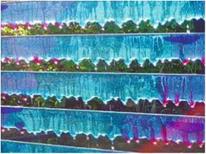

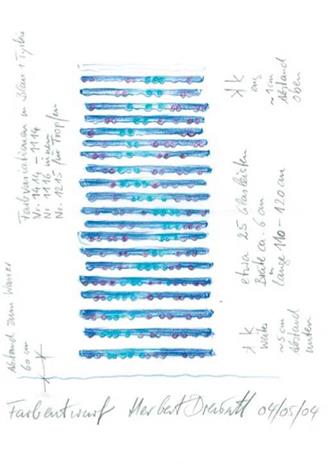
![]()
![]()
|
|
![]()

![]()
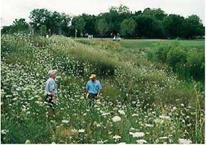
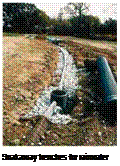

Without their craving for new things, without their inventiveness we would probably still not drink Coca-Cola, not put on baseball caps, would still pay cash at the petrol station and write our books and articles on typewriters. Americans enjoy their extravagant lifestyle, but inevitably come up against barriers from time to time, and are thus constantly looking for ways round them.
For example, the United States has come perilously close to an abyss with its settlement policy. There seems to be no lack of land, and yet it is worth nothing without the resource of water, and this is now scarce in a number of places. And so a project developer in the state of Indiana laid the foundation stone for a model settlement that also set standards. It is strongly oriented towards pedestrians and cyclists, efficient energy use, healthy building materials and development density, and as well as all this it is highly committed to intelligent water management. The only water worth mentioning before building started is Coffee Creek, from which the area takes its name.
In 1996, Herbert Dreiseitl made contact with an American planning group, and three years later he joined the team of landscape architects and hydraulic engineers responsible for sections of the creative and hydraulic open air planning for Coffee Creek. The project makes additional heavy demands because it is close to a conservation area. A master plan fixed the main rainwater management requirements: precipitation water flows via trenches with slits to infiltration areas that are topographically staggered one behind the other. These are completely planted with prairie vegetation with roots systems that are highly water absorbent. The entire system is able to contain once-in-a-century crisis rainfall within the area and allow it to soak away.
An estate intended to provide 1,200 residential units can only be built in an ecologically acceptable way with a cleverly devised system for the water technology infrastructure. But this infrastructure will not be visible – in fact the water will appear in natural stream beds, in ponds that run into each other over massive cascades piled up from natural stone slabs, producing a charming open space.
This complex water management will enable typical woods and prairies areas to survive – also because the entire water situation of the area, which covers a total of 260 hectares, will remain unchanged.

